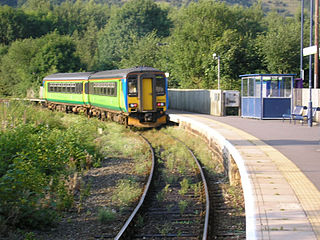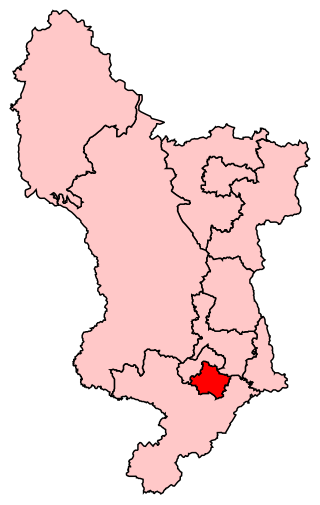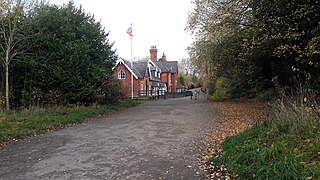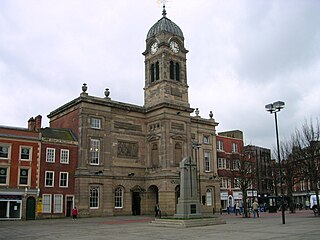
The Catacombs of Paris are underground ossuaries in Paris, France, which hold the remains of more than six million people in a small part of a tunnel network built to consolidate Paris's ancient stone quarries. Extending south from the Barrière d'Enfer former city gate, this ossuary was created as part of the effort to eliminate the city's overflowing cemeteries. Preparation work began shortly after a 1774 series of basement wall collapses around the Holy Innocents' Cemetery added a sense of urgency to the cemetery-eliminating measure, and from 1786, nightly processions of covered wagons transferred remains from most of Paris's cemeteries to a mine shaft opened near the Rue de la Tombe-Issoire.

Catacombs are man-made subterranean passageways for religious practice. Any chamber used as a burial place is a catacomb, although the word is most commonly associated with the Roman Empire.

West Norwood Cemetery is a 40-acre (16 ha) rural cemetery in West Norwood in London, England. It was also known as the South Metropolitan Cemetery. One of the first private landscaped cemeteries in London, it is one of the "Magnificent Seven" cemeteries of London, and is a site of major historical, architectural and ecological interest.
Hawkesley is an area of Birmingham, England. It is part of 'The Three Estates', the housing estates Hawkesley, Pool Farm, and Primrose. These are to the south of Kings Norton. The Ordnance Survey grid reference is SP0477.
Columbia University in New York City has an extensive tunnel system underneath its Morningside Heights campus connecting many of its buildings, used by the university as conduits for steam, electricity, telecommunications, and other infrastructure. Throughout their history, the tunnels have also been used for other purposes, mostly centering around transportation. During the first half of the 20th century, they were used by students to avoid aboveground traffic. When the university housed the Manhattan Project, they were allegedly used to move radioactive material between buildings. During the Columbia University protests of 1968, students used the tunnels to facilitate their occupation of buildings on campus.

Ambergate railway station is a railway station owned by Network Rail and managed by East Midlands Railway. It serves the village of Ambergate in Derbyshire, England. The station is located on the Derwent Valley Line from Derby to Matlock, which diverges from the Midland Main Line just south of the station at Ambergate Junction.

Derby South is a constituency formed of part of the city of Derby represented in the House of Commons of the UK Parliament since 1983 by veteran MP Margaret Beckett of the Labour Party. She has served under the Labour governments of Harold Wilson, James Callaghan, Tony Blair and Gordon Brown. She became interim Leader of the Labour Party in 1994 when John Smith suddenly died. She has also served under Neil Kinnock and Smith himself.
The Pitkin Tunnel or Pitkin Street Tunnel is a below-ground-level, roofed but not entirely enclosed roadway, in downtown New Haven, Connecticut, United States. It accommodates simultaneous motor vehicle traffic in both directions. The tunnel runs from the eastbound one-way Elm Street between Church and Orange Streets, with the southbound lanes of State Street between Court and Chapel Streets across from State Street station. It passes under Orange Street. It runs under or next to the New Haven City Hall and County Courthouse and the Federal Courthouse on Church Street, the local Emergency Operations Center, and at least three more buildings that house banks and the headquarters of United Illuminating, the electric utility serving much of New Haven and Fairfield counties.

The Diocese of Derby is a Church of England diocese in the Province of Canterbury, roughly covering the same area as the County of Derbyshire. Its diocesan bishop is the Bishop of Derby whose seat (cathedra) is at Derby Cathedral. The diocesan bishop is assisted by one suffragan bishop, the Bishop of Repton.

Derby Friargate railway station was the main station in Derby on the Great Northern Railway Derbyshire Extension, popularly known as the (Derby) Friargate Line.

The Odesa Catacombs are a labyrinth-like network of tunnels located under the city of Odesa and its outskirts in Ukraine, that are mostly the result of stone mining, particularly coquina. The system of Odesa Catacombs consists of a network of basements, bunkers, drainage tunnels and storm drains as well as natural caves.

St Christopher le Stocks was a parish church on the north side of Threadneedle Street in the Broad Street Ward of the City of London. Of Medieval origin, it was rebuilt following the Great Fire of London in 1666, but demolished in 1781 to make way for an extension of the neighbouring Bank of England.
Gedling and Carlton railway station was a former railway station built to serve the villages of Gedling and Carlton in Nottinghamshire.

Mickleover railway station is a disused railway station which served the village of Mickleover, Derbyshire, England. It was opened by the Great Northern Railway on its Derbyshire Extension in 1878.

New Basford railway station was a station in Nottingham on the Great Central Railway main line, the last main line to be built from the north of England to London. The station opened with the line on 15 March 1899.

The Lowell Holly Reservation is a 135-acre (0.55 km2) nature reserve in Mashpee and Sandwich, Massachusetts and is managed by the Trustees of Reservations. The area was extensively planted by Abbot Lawrence Lowell and Wilfred Wheeler with rhododendrons, mountain laurel and holly trees, for which the reservation gets its name. There are 4 miles (6.4 km) of hiking trails and two peninsular knolls that jut into Mashpee Pond and Wakeby Pond. Abbot Lawrence Lowell bequeathed the property to the Trustees of Reservations in 1943.
Léon-Provancher Ecological Reserve is an ecological reserve in Quebec, Canada. It was established in 1999.

38–39 Bayley Lane is a former building, whose present-day site is accessible from the Herbert Art Gallery and Museum in Coventry, England. All that remains is the medieval undercroft, a fourteenth-century cellar that initially belonged to a wealthy merchant, who was a clothier. The undercroft is built with sandstone with a stone-ribbed vault for added security and strength. It is a Grade I listed building.

Derby Guildhall is a municipal building in the Market Place, Derby, England. It is a Grade II listed building.
The Ħal Resqun catacombs at Gudja, are interpreted as early Christian catacombs or paleochristian hypogea in Malta. The Ħal Resqun catacombs are especially notable for their carved decorations, and other features which are uncommon in Maltese catacombs, and of exceptional value. Some historians have suggested that, unlike other catacombs, those at Ħal Resqun portray enough Christian markers to be classified as paleochristian remains, while others view these features to be inconclusive. Some of the graffiti, interpreted by a number of historians as portraying a biblical scene, are thought to be unique in the world, and considered one of the most important remains from Late Antiquity in Malta.














